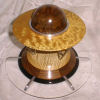i guess to me it's about simple shop work. There are many ways to make curved shapes that look okay but are not mathematically correct. I used the framing square method also that comes out closer to an ellipse. The string and pin method also. The easiest and most accurate is to CNC it and be done. I've used battens for curves also it works just fine. I guess I thought we were talking a simple string here.
Jim






 Reply With Quote
Reply With Quote




